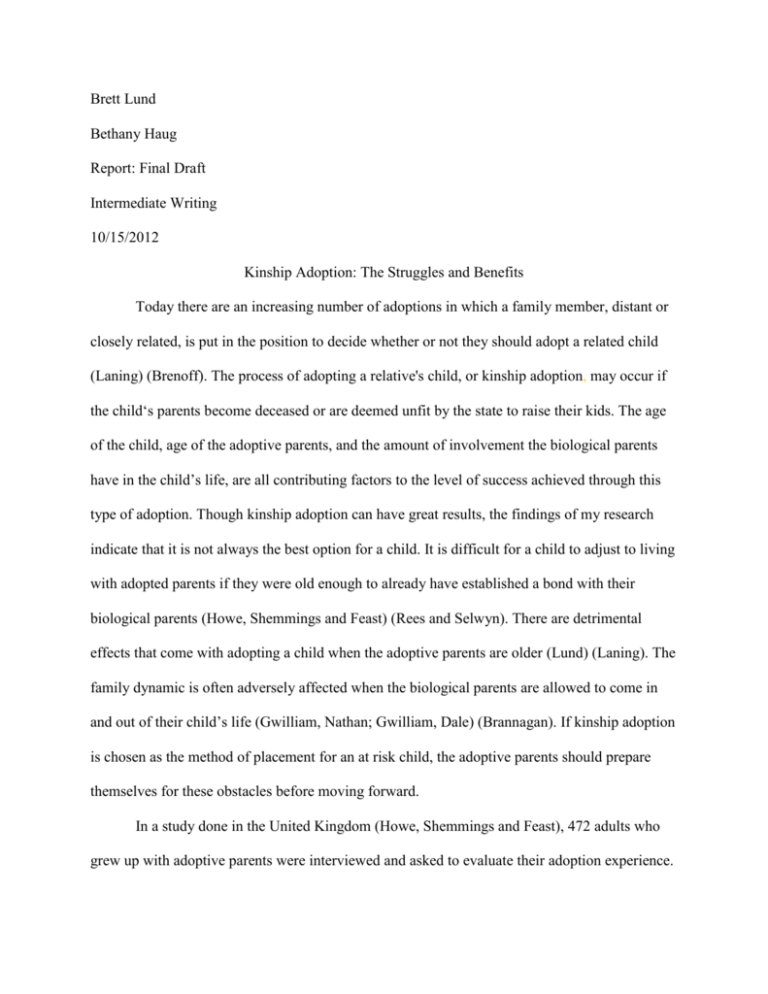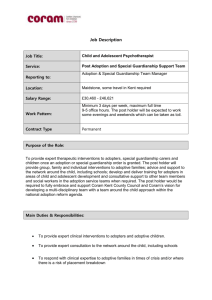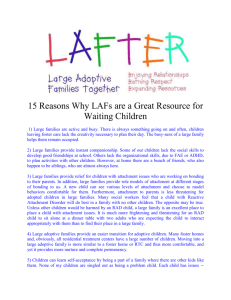File
advertisement

Brett Lund Bethany Haug Report: Final Draft Intermediate Writing 10/15/2012 Kinship Adoption: The Struggles and Benefits Today there are an increasing number of adoptions in which a family member, distant or closely related, is put in the position to decide whether or not they should adopt a related child (Laning) (Brenoff). The process of adopting a relative's child, or kinship adoption, may occur if the child‘s parents become deceased or are deemed unfit by the state to raise their kids. The age of the child, age of the adoptive parents, and the amount of involvement the biological parents have in the child’s life, are all contributing factors to the level of success achieved through this type of adoption. Though kinship adoption can have great results, the findings of my research indicate that it is not always the best option for a child. It is difficult for a child to adjust to living with adopted parents if they were old enough to already have established a bond with their biological parents (Howe, Shemmings and Feast) (Rees and Selwyn). There are detrimental effects that come with adopting a child when the adoptive parents are older (Lund) (Laning). The family dynamic is often adversely affected when the biological parents are allowed to come in and out of their child’s life (Gwilliam, Nathan; Gwilliam, Dale) (Brannagan). If kinship adoption is chosen as the method of placement for an at risk child, the adoptive parents should prepare themselves for these obstacles before moving forward. In a study done in the United Kingdom (Howe, Shemmings and Feast), 472 adults who grew up with adoptive parents were interviewed and asked to evaluate their adoption experience. Age at placement was the main focus of the study. Respondents were asked if they felt loved by their adoptive family, felt like they belonged in their adoptive family, and if their overall evaluation of their experience was positive or negative. The risk of viewing major aspects of their adoption experience negatively increased significantly as the age at placement increased. The study also indicated that children placed at an older age also suffered an increased risk of poor mental health, behavioral problems, and relationship difficulties. The contrast noted between children 12 months and younger, and children 24 months and older, was notable (Howe, Shemmings and Feast). Of those children placed before 12 months, 54% said they strongly agreed that they felt they belonged in their adoptive family. This number dropped all the way down to 19% among those who were placed after 24 months. Of those placed before 12 months, 52% said they did not feel different to their adoptive family. Only 33% answered the same way among those placed after 24 months. Among those placed before 12 months, 68% strongly agreed that they felt loved by their adoptive mother. This number decreased to 30% among those placed after 24 months. When asked if they felt loved by their adoptive father, the percentages dropped from 69% among the younger group to 29% among the older group. The first year was described by most parents as “challenging, though rewarding.” They reported experiencing depression, anxiety, and even marital problems. It was not uncommon for the adoptees to suffer from learning difficulties, conduct problems, and health problems (Howe, Shemmings and Feast). This change in a child’s perception of his/her place in the family can complicate the adoption process. This is a trend that adoptive parents should not ignore and be prepared to address. Another study performed in the United Kingdom (Rees and Selwyn), explored the outcome of adoption with children slightly older (between 3-11 years) when placed with an adoptive family. 130 children, all in local authority care for protective reasons, were considered. Information was gathered to evaluate the effectiveness of adoption as a method to remedy abusive or neglectful situations, as opposed to institutional care. The authors presented evidence that adopting children in this age group proves difficult for the adopters. Contact arrangements with birth parents added to the complexity of the task. A group of adopters were asked to consider the rewards they perceived within their experiences of adopting older children who were removed from their homes for safety reasons. Of the respondents, 62% described “sometimes considerable difficulties, tempered by the rewards of progress.” Still 10% couldn’t identify any rewards from the process at all. Some parents admitted they had thought the warnings of expected difficulty were being exaggerated and that their desire to parent had caused them to be less objective (Rees and Selwyn). If a challenging scenario is anticipated, parents will be better prepared to deal with problems if they should occur. The age of the adoptive parents at the time of adoption should also be considered in correlation with the age of the child. During an interview with Verna Lund (Lund), she stated that her main point of concern was her age and the age of her husband when they participated in kinship adoption. They adopted three girls who were sisters that had become a ward of the state. One of them was four years old at the time of placement. Verna questioned her own capability of giving her daughters the attention needed from a parent. It takes a lot of energy to discipline teenagers, help them with school work, and stay involved in their active lives. Verna lost her husband to heart failure a few years ago and the task of raising three teenage girls in her senior years became a much tougher task. It affected the girls as well. They became fearful that they would also soon lose their mother. Their grades in school declined and they started getting into more and more trouble. They were angry, scared, and confused. Any child would be when dealing with the loss of a parent, but Verna expressed guilt for putting the girls in a position where this kind of loss was more likely than it would be with younger parents (Lund). In his book Latecomers (Laning), author Andrew Yarrow reports the results of research concerning adults who were born into families with older parents. As children, the subjects of the study said there were upsides along with downsides. Older parents were able to provide a more stable atmosphere. They did, however, recall feeling embarrassed about their parent’s lack of stamina and gray hair. They had to explain that their parents were older and that they actually weren’t their grandparents. Many of the subjects reported being haunted by a constant concern for their parents’ health, and feared they might lose them. As adults, they had to become caretakers of aging parents when most of their peers still had parents that were quite active. They felt this was unfair as they were still caring for their own young children. They felt it was also unfair to their own children because they would be cheated out of having a long term relationship with their grandparents (Laning). In an article published by The Huffington Post called, “Too Old to Adopt”? Not the Case for These Parents (Brenoff), the author reports five cases of adoption involving older adoptive parents. When interviewed, these adoptive parents reported some obstacles and recalled dealing with a lot of “crazy and endless questions” (Brenoff). Even so, they were undeterred and thrilled with the outcome of their decision to adopt. Their children brought joy to their lives and they felt they were able to offer the love and nurturing that every child needs (Brenoff). Since these kind of adoptions are quite common and recognized as helpful in many cases, people are becoming educated as to their options and learning the best way to plan. The annual New England Adoption Conference is the largest U.S. adoption conference with roughly 1600 attending (Laning). To help with the preparation process they offer a special workshop for those who are over 40 and hoping to adopt. This workshop has drawn over 150 attendees each year. Adoption of a child that is not an infant is already a complex task when biological parents aren’t related to the adoptive parents (Gwilliam, Nathan; Gwilliam, Dale). Emotional ties have to be severed, then, re-established with new parents. In cases of neglect and drug abuse, this can become more confusing if the biological parents are still somewhat present in their children’s lives (Brannagan). It is difficult to withhold a family member’s privilege to see their biological children. The family dynamic will be affected in any kinship adoption. As many people are not willing to allow their niece/nephew, grandchild, or close friend’s child, to be adopted by strangers, potential adoptive parents should consider this information when deciding how to move forward. Potential problems can be planned for and possibly averted before they become relevant. In some cases, such as the death of a child’s parents, it may be easier for the child to adjust if they’re adopted by a family member, or friend of the family that they’re familiar with. The bonds within the family can be maintained and even strengthened when the relationship becomes legal. This way the child can grieve the loss of his/her parent(s), without also having to adapt to completely new surroundings. Preference is given to relatives in most states when deciding who should take custody of a child that has become a ward of the state. This is the case in Utah as long as the relative is found to be fit, as per Code; 78A-6-307 (Gateway). Though adoption as a therapeutic option for traumatized children is proven to be challenging, especially for older parents, it is better than the alternative of leaving children in institutional care for extended periods of time (Rees and Selwyn). Since leaving children in an abusive home where they are at risk of enduring damaging experiences is simply not an option, someone needs to be up to the task of taking them in and raising them. When approaching a decision to either participate in kinship adoption, or allow a family member’s child to be adopted by strangers, potential parents must consider the difficulties and evaluate their own resolve. Many times, allowing a child to be placed outside of the family with young, energetic, loving parents will turn out more beneficial for the child in the long run. It is easier for adopters who are not related to the biological parents to enforce separation of the child from the biological parents, which reduces confusion. Often relatives of children who are a ward of the state are understandably unwilling to allow them to be taken outside of the family. Kinship adoption can still be a good, viable option. Adopters do need to be adequately prepared for the various situations they will have to deal with, be ready to make tough decisions, and plan accordingly. Works Cited Brannagan, Meg. "What is Required to Adopt a Child Within the Family." Livestrong.com. 18 July 2010. Web. 20 September 2012. Brenoff, Ann. "Too Old to Adopt? Not the Case for These Parents." Huffingtonpost.com. 3 July 2012. Web. 20 September 2012. Gateway, Child Welfare Information. ""Placement of Children With Relatives."." July 2010. www.childwelfare.gov. Web. 20 November 2012. Gwilliam, Nathan; Gwilliam, Dale. "How do I Adopt a Family Member." Adoption.com. n.d. Web. 20 September 2012. Howe, David, David Shemmings and Julia Feast. Age at Placement and Adult Adopted People's Experience of Being Adopted. Research Project. London, UK: Blackwell Science Ltd, 2001. Print. 20 September 2012. Laning, Betty. "When are you 'Too Old' to Adopt" Rainbowkids.com. 1 June 2006. Web. 20 September 2012. Lund, Verna. Adoptive Parent Brett Lund. September 2012. Rees, C.A and J. Selwyn. Non-Infant Adoption from Care: Lessons for Saveguarding Children. Journal. Bristol, UK: Blackwell Publishing Ltd, 2009. Print. 20 September 2012.








